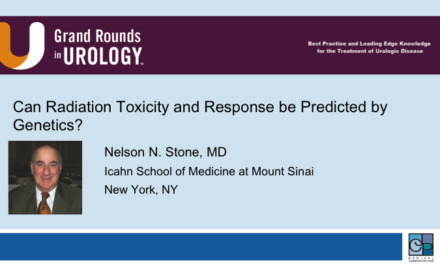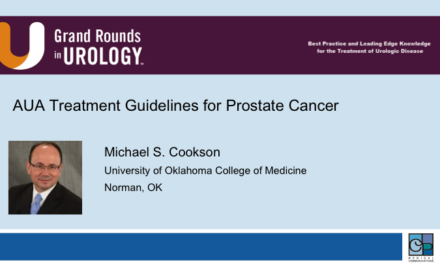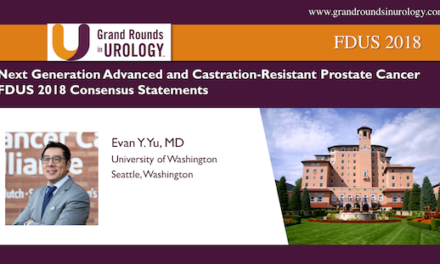Dr. Leonard G. Gomella spoke at the 25th International Prostate Cancer Update on Friday, January 23, 2015 on “Side Effects of Therapy: From Hot Flashes to Cardiovascular Issues.”
Keywords: androgen deprivation therapy, complications, metabolic syndrome
How to cite: Gomella, Leonard G. “Side Effects of Therapy: From Hot Flashes to Cardiovascular Issues” Grand Rounds in Urology. April 28, 2015. Accessed Dec 2024. https://dev.grandroundsinurology.com/prostate-cancer-leonard-g-gomella-side-effects-of-therapy/.
Transcript
Side Effects of Therapy: From Hot Flashes to Cardiovascular Issues
We all know we’re using more and more androgen deprivation. There has been a dramatic increase over the last 25 to 30 years, and of course we all know the target organs very well in our field of testosterone, muscle problems, sexual organ issues, heart, brain, mood, skin, many different things could be affected by testosterone.
But clearly what we do when we treat patients with androgen deprivation across the spectrum of prostate cancer has been called many different things, LHRH syndrome, medical andropause, but it’s a constellation of symptoms and conditions, and again the growing concern that we have is that since men are living longer and longer and longer with advanced stages of prostate cancer, the long term implications of androgen deprivation is becoming very, very important to us all.
And again, everyone here is well aware of the common adverse effects of androgen deprivation therapy. Arturo gave a nice overview this morning of some of these. In our limited amount of time we’re not going to be able to hit all of these but we’re going to do a high level look at the very common ones that we run into and the ones that are getting a lot of attention particularly with the chronicity of the use of androgen deprivation therapy.
One of the big problems is a change in metabolism, and the men all tend to develop a lot of sarcopenia, central abdominal obesity, and we know that in addition to this that the GnRH agonist significantly increase serum lipids in men who are treated with prostate cancer and particularly there’s a dramatic increase in triglycerides. All of this contributes to the truncal obesity and some of the issues that we’re going to have talking about cardiovascular diseases. The other thing that’s been well document is that there is a significant decrease in insulin sensitivity, even in men who are not diabetic who are treated with LHRH analogs.
Now the big controversy out there that has been bantered back and forth is the connection between coronary heart disease and diabetes and other metabolic syndrome factors. The bottom line is that all studies have been consistent in showing that there is an association between taking prediabetics and converting them to a diabetic state or affecting insulin sensitivity or resistance. However, the coronary heart disease is much more controversial in the literature and it is not universally supported. So what do we basically do from a practical standpoint? All men who are treated with LHRH analogs and androgen deprivation therapy in particular should be considered for hemoglobin A1c testing. A lot of this is going to come up in the end of being done in coordination with the primary care provider and that’s a lot of the take home messages that we’re having right now since a lot of these issues affect blood pressure and diabetes risk, coordinating with the primary care practitioner, Matt Rosenberg [phonetic] made some of those comments the other day in some of his introductory talks, becomes increasingly important.
Managing prediabetes, these patients should be monitored periodically for hemoglobin A1c. And again, lifestyle interventions in patients LHRH analog and androgen deprivation therapy are going to becoming back over and over again in many of the areas that we’re going to be talking about. Weight loss is very important, and maintaining a physical activity is going to be important combating a lot of the side effects of androgen deprivation therapy.
What about the issue of cardiovascular disease? Again, recognizing that it is somewhat controversial. We impart that the patients do the commonsense things that we’re all now encouraged to do. Tobacco cessation, primary prevention, making sure that patients have lipid profiles done. Again usually in coordination with the primary care doctors and using the national guidelines for management of cholesterol in the adult treatment program are usually done in coordination with the primary care doctor. Again, a lot of this starts to get in the men’s health issues but we’re really talking now about the management of patients with prostate cancer which I think a lot of these issues are really more appropriately handled by primary care doctors. That’s why I think it’s important, unless you’re equipped to do this in your office to keep the primary care doctor in the loop. Of course the controversial area of the use of low dose aspirin, again based on coronary heart disease risk is also something you should consider. And again, hyperlipidemia which goes along with androgen deprivation therapy, again should be instituted if lifestyle changes, physical activity and management of central obesity is not successful.
We get a lot of attention in this one, androgen deprivation therapy in bone related complications and it causes a lot of problems for many patients. Again, many patients do not have an issue with bone related complications, but unfortunately those that do have a skeletal related complication increase medical costs, do have problems with impaired mobility, they do have a diminished quality of life, and unfortunately the biggest thing is the negative impact on overall survival.
We know well proven men on androgen deprivation therapy are at an increased risk of fracture and that the 20% of men on ADT who survived at least five years are at risk for some type of a fracture. The key factors in an androgen deprivation therapy setting are how long you’ve been on the ADT, how much bone loss you have and age. The older patients certainly suffer much more with osteoporosis and osteopenia than do the younger men. And again, we mentioned that fractures can reduce survival significantly particularly hip fractures.
Again recommendations, what do most of the papers in the large organizations recommend? Obtaining a baseline DXA scan before starting androgen deprivation comes up in a lot of different guidelines, and considering for doing that every two years. Counsel men on exercise. Fall prevention, that’s a big problem with these fractures, most of them are usually induced with a fall. We’ll talk a little bit about calcium and vitamin supplementation because that ball is swinging back and forth a little bit. And again, physical activity, commonsense things, decreased alcohol intake and stopping smoking, again another beneficial area.
Supplementations, vitamin D, most older men are actually vitamin D deficient in the United States. You can go ahead and check vitamin D levels but the recommendation is around 1000 to 2000 IU daily. Calcium supplementation has been a little bit controversial and why is that? Because there have been multiple papers out there that say that men regardless of the androgen deprivation therapy or not who take greater than 1000 mg of calcium a day are actually at greater risk of having a cardiovascular disease mortality and the fact it could be as high as 20%. The new recommendation is, is that vitamin D supplementation is good but the calcium should probably come through the diet and if someone can’t get at least 600 mg a day then you should consider supplementation. But no longer is it a knee jerk to hyper supplementations with calcium. Certainly if needed, we have many pharmacological agents which now are available.
We have oral and IV bisphosphonates which are FDA approved. And of course we have denosumab which is a RANK ligand inhibitor. A fascinating thing when I was putting this talk together is that a paper came out in late 2014 that has looked at the use of pharmacologic treatments for men on androgen deprivation therapy, and in spite of all our talk this, this recent study showed that only 3.4% of men in a Medicare database who are on androgen deprivation therapy were actually receiving a bisphosphonate or denosumab. Very interesting, so something we talk about a lot but when people looked at the literature, this number peaked at about 8% in I think the 2006 to 2010 range and now it’s only down to about 3.5%.
Something you have to remember with the oral bisphosphonates is of course the side effect if you choose to use them. Osteonecrosis of the jaw is the big one that comes up. This is now a class warning for all bisphosphonates whether they’re systemically administered or they’re orally administered.
Severe hypocalcemia can occur with denosumab, more likely to recur with denosumab than with the bisphosphonates. It is recommended if you are going to use denosumab to monitor not only calcium and vitamin D but also check magnesium levels since there can be problems with low levels of magnesium. And again you should educate men on the problems of hypocalcemia, and if they have any type of paresthesias or muscle cramping or tetany, they really need to have their calcium and their magnesium levels checked acutely.
Osteonecrosis of the jaw can be seen with both denosumab and bisphosphonates way back when we thought it was only going to be bisphosphonates, now it can be seen also with denosumab. And the 95% of the patients who get osteonecrosis of the jaw are cancer patients who have received IV bisphosphonate or denosumab often after undergoing an invasive dental procedure either with extraction or an implant, so it’s very important that patients before you start them on a bisphosphonate or a bone health agent that you have them have a good dental examination.
Osteoporosis by DXA, everybody is familiar with this. If you have access and your carrier lets you do DXA scanning, it’s a good idea to go ahead and do that.
This is a very useful tool, the FRAX risk assessment for these patients but the bottom line is that screening the men for bone mineral density is reasonable. And again if someone has a fracture you should really think about going head and putting them on an agent if you want to go beyond the standard calcium exercise, alcohol, recommendations.
Hot flashes, vasomotor instability are fairly common. Some men are not bothered by it, other men as we all know are significantly involved with it. If we can identify triggers, and give men some behavioral changes that will help them, that is often useful.
Hot flashes, there’s been innumerable therapies described in the literature, standard medications, as well as alternative therapy such as lifestyle modification, acupuncture, and soy and other agents.
What does the randomized clinical trial data show us for hot flashes? Gapapentin has been shown to reduce the frequency. The other agents noted there have all reduced hot flashes, however, soy protein alone or in combination was not found to be particularly helpful so all of the comments about soy and hot flashes in women don’t necessarily apply in the randomized clinical trial data. But there are some medications again that can be used which are available.
What else can we do for men who have ADT related problems? Again, randomized clinical trials, there is innumerable papers out there. We did this in this work. We did this in this work. What we try to focus on in this talk is what has been shown in randomized clinical trials. Fatigue, aerobic exercise and resistance exercise has been shown to help men with fatigue. Remember we also talked about the exercise for things such as the sarcopenia. Gynecomastia, again a common problem in some men, many individual agents have been tried but if you look at the randomized clinical trials, radiation and tamoxifen both can reduce gynecomastia compared with observation alone, but if you look, a hard look at the randomized clinical trials, tamoxifen is probably more affected than radiation and potentially has less side effects of worrying about secondary radiation effects in the chest. And interesting, very little data out there on sexual dysfunction in androgen deprivation therapy, but it looks like the best papers out there right now are intermittent androgen deprivation, and aerobic exercise along with resistance exercise. Again, this concept of exercise, exercise, exercise keeps coming back over many, many different areas.
Arturo gave a good talk this morning on intermittent androgen deprivation. Clearly it’s a little controversial but it is undeniable that the side effect profile of intermittent androgen deprivation therapy is superior to continuous androgen deprivation therapy.
What are a few bottom lines we can look at? This is from the consensus from the AUA, ACS, AUA and ASTRO that there is an increased risk of diabetes and possibly cardiovascular events although most published studies report that ADT is not linked to greater cardiovascular mortality. We know that it can impact lipids, insulin sensitivity and cause obesity. And they should be followed by their primary care physician unless you’re well equipped to do this in your office and monitor blood pressure, lipid levels, and glycemic indices.
It seems that there’s not specific intervention that can reduce cardiovascular morbidity or mortality. If it does exist in patients, treat with androgen deprivation therapy, and again this is something I know Dr. Morgentaler will probably address tomorrow when it comes to using testosterone supplementation. Men on ADT with cardiac, known cardiac disease should receive standard prevention and interventions that are well published and well known in the primary care literature.
Other things that you should do, you should get a baseline BMI, waist circumference, fasting blood glucose, oral glucose, tolerance test, if the fasting isn’t normal, and lipid profiles. Again, this is things you can order as a baseline, and then refer over to the private primary care doctors. Again lifestyle intervention, very, very, very critical.
And lastly we talked about the monitoring men for the skeletal complications, and again lifestyle intervention is very important. Remember two much calcium in these men may be worse than not enough calcium. And again, if someone experiences a fracture, there’s no question they should go on a bone supplemental health agent to either denosumab or bisphosphonate. However, looking at DXA scans, if your insurance companies will let you get them can be something that can guide you.
References
Boccon-Gibod L, Hammerer P, Madersbacher S, et al. The role of intermittent androgen deprivation in prostate cancer. BJU Int. 2007 Oct;100(4):738-43.
http://www.ncbi.nlm.nih.gov/pubmed/17662079
Dawson-Hughes B, Heaney RP, Holick MF, et al. Estimates of optimal vitamin D status. Osteoporos Int. 2005 Jul;16(7):713-6.
http://www.ncbi.nlm.nih.gov/pubmed/15776217
Engstrom C. Hot flash experience in men with prostate cancer: a concept analysis. Oncol Nurs Forum. 2005 Sep 1;32(5):1043-8.
http://www.ncbi.nlm.nih.gov/pubmed/16136202
Gleave M, Klotz L, Taneja SS. The continued debate: intermittent vs. continuous hormonal ablation for metastatic prostate cancer. Urol Oncol. 2009 Jan-Feb;27(1):81-6.
http://www.ncbi.nlm.nih.gov/pubmed/19111804
Groot MT, Boeken Kruger CG, Pelger RC, et al. Costs of prostate cancer, metastatic to the bone, in the Netherlands. Eur Urol. 2003 Mar;43(3):226-32.
http://www.ncbi.nlm.nih.gov/pubmed/12600424
Grossmann M, Zajac JD. Androgen deprivation therapy in men with prostate cancer: how should the side effects be monitored and treated? Clin Endocrinol (Oxf). 2011 Mar;74(3):289-93.
http://www.ncbi.nlm.nih.gov/pubmed/21092052
Gulamhusein H, Yun L, Cheung AM, et al. Bisphosphonate prescriptions in men with androgen deprivation therapy use. JAMA. 2014 Dec 3;312(21):2285-6.
http://www.ncbi.nlm.nih.gov/pubmed/25462000
Heaney RP, Dowell MS, Hale CA, et al. Calcium absorption varies within the reference range for serum 25-hydroxyvitamin D. J Am Coll Nutr. 2003 Apr;22(2):142-6.
http://www.ncbi.nlm.nih.gov/pubmed/12672710
Kanis JA, Melton LJ 3rd, Christiansen C, et al. The diagnosis of osteoporosis. J Bone Miner Res. 1994 Aug;9(8):1137-41.
http://www.ncbi.nlm.nih.gov/pubmed/7976495
Khosla S, Burr D, Cauley J, et al. Bisphosphonate-associated osteonecrosis of the jaw: report of a task force of the American Society for Bone and Mineral Research. J Bone Miner Res. 2007 Oct;22(10):1479-91.
http://www.ncbi.nlm.nih.gov/pubmed/17663640
Larsson SC. Are calcium supplements harmful to cardiovascular disease? JAMA Intern Med. 2013 Apr 22;173(8):647-8.
http://www.ncbi.nlm.nih.gov/pubmed/23380757
Levine GN, D’Amico AV, Berger P, et al. Androgen-deprivation therapy in prostate cancer and cardiovascular risk: a science advisory from the American Heart Association, American Cancer Society, and American Urological Association: endorsed by the American Society for Radiation Oncology. CA Cancer J Clin. 2010 May-Jun;60(3):194-201.
http://www.ncbi.nlm.nih.gov/pubmed/20124400
Nguyen PL, D’Amico AV. Toward Personalizing the Use of Androgen Deprivation Therapy to Maximize Benefit and Minimize Harm. Eur Urol. 2014 Dec 23. pii: S0302-2838(14)01274-3.
http://www.ncbi.nlm.nih.gov/pubmed/25542627
Oefelein MG, Ricchiuti V, Conrad W, et al. Skeletal fractures negatively correlate with overall survival in men with prostate cancer. J Urol. 2002 Sep;168(3):1005-7.
http://www.ncbi.nlm.nih.gov/pubmed/12187209
Riggs BL, Melton LJ 3rd. The worldwide problem of osteoporosis: insights afforded by epidemiology. Bone. 1995 Nov;17(5 Suppl):505S-511S.
http://www.ncbi.nlm.nih.gov/pubmed/8573428
Saad F, Olsson C, Schulman CC. Skeletal morbidity in men with prostate cancer: quality-of-life considerations throughout the continuum of care. Eur Urol. 2004 Dec;46(6):731-39; discussion 739-40.
http://www.ncbi.nlm.nih.gov/pubmed/15548440
Saylor PJ, Smith MR. Metabolic complications of androgen deprivation therapy for prostate cancer. J Urol. 2009 May;181(5):1998-2006; discussion 2007-8.
http://www.ncbi.nlm.nih.gov/pubmed/19286225
Saylor PJ, Smith MR. Adverse effects of androgen deprivation therapy: defining the problem and promoting health among men with prostate cancer. J Natl Compr Canc Netw. 2010 Feb;8(2):211-23.
http://www.ncbi.nlm.nih.gov/pubmed/20141678
Saylor PJ, Keating NL, Smith MR. Prostate cancer survivorship: prevention and treatment of the adverse effects of androgen deprivation therapy. J Gen Intern Med. 2009 Nov;24 Suppl 2:S389-94.
http://www.ncbi.nlm.nih.gov/pubmed/19838837
Shahinian VB, Kuo YF, Freeman JL, et al. Risk of the “androgen deprivation syndrome” in men receiving androgen deprivation for prostate cancer.
Arch Intern Med. 2006 Feb 27;166(4):465-71.
http://www.ncbi.nlm.nih.gov/pubmed/16505268
Shahinian VB, Kuo YF, Freeman JL, et al. Risk of fracture after androgen deprivation for prostate cancer. N Engl J Med. 2005 Jan 13;352(2):154-64.
http://www.ncbi.nlm.nih.gov/pubmed/15647578
Smith MR, Finkelstein JS, McGovern FJ, et al. Changes in body composition during androgen deprivation therapy for prostate cancer. J Clin Endocrinol Metab. 2002 Feb;87(2):599-603.
http://www.ncbi.nlm.nih.gov/pubmed/11836291
Smith MR, Lee H, Nathan DM. Insulin sensitivity during combined androgen blockade for prostate cancer. J Clin Endocrinol Metab. 2006 Apr;91(4):1305-8.
http://www.ncbi.nlm.nih.gov/pubmed/16434464
Taylor LG, Canfield SE, Du XL. Review of major adverse effects of androgen-deprivation therapy in men with prostate cancer. Cancer. 2009 Jun 1;115(11):2388-99.
http://www.ncbi.nlm.nih.gov/pubmed/19399748
Thompson CA, Shanafelt TD, Loprinzi CL. Andropause: symptom management for prostate cancer patients treated with hormonal ablation. Oncologist. 2003;8(5):474-87.
http://www.ncbi.nlm.nih.gov/pubmed/14530501
Tunn U. The current status of intermittent androgen deprivation (IAD) therapy for prostate cancer: putting IAD under the spotlight. BJU Int. 2007 Jan;99 Suppl 1:19-22; discussion 23-4.
http://www.ncbi.nlm.nih.gov/pubmed/17229164
Weinfurt KP, Li Y, Castel LD, et al. The significance of skeletal-related events for the health-related quality of life of patients with metastatic prostate cancer. Ann Oncol. 2005 Apr;16(4):579-84.
http://www.ncbi.nlm.nih.gov/pubmed/15734776
Woo SB, Hellstein JW, Kalmar JR. Narrative [corrected] review: bisphosphonates and osteonecrosis of the jaws. Ann Intern Med. 2006 May 16;144(10):753-61.
http://www.ncbi.nlm.nih.gov/pubmed/16702591
ABOUT THE AUTHOR
Leonard Gomella, MD, FACS, is the Bernard W. Godwin, Jr., Professor of Prostate Cancer and Chairman of the Department of Urology at the Sidney Kimmel Medical College of Thomas Jefferson University. He joined the Jefferson faculty in 1988 and was appointed Chair in 2002. He serves as Senior Director for Clinical Affairs for the NCI-designated Sidney Kimmel Cancer Center, Clinical Director of the SKCC Network, and Urology Chair for NRG (RTOG). Dr. Gomella is involved in translational basic science and clinical research in the development of new diagnostic techniques and treatments for prostate and bladder cancer through the Sidney Kimmel Cancer Center as Co-Leader of the Biology of Prostate Cancer Program. In 1992, he led the team that first used molecular techniques to detect circulating tumor cells in prostate cancer. He has given over 500 presentations, written over 400 papers, and edited dozens of chapters and monographs in the field of urology. Dr. Gomella has authored and edited many editions of a number of books for medical students, residents, and practicing physicians, including the “Clinician’s Pocket Reference” (aka “The Scut Monkey Book”) and “Five Minute Urology Consult.” He is also Editor-in-Chief of the Canadian Journal of Urology. “Recovering from Prostate Cancer,” which Dr. Gomella wrote in 1993, was the first book released for the general public specifically on the topic of prostate cancer.
“Best Doctors in America,” “Top Doctors for Cancer,” and Philadelphia Magazine’s “Top Doctors” have recognized him for many years for his contributions to urologic oncology and prostate cancer care. He also received national recognition in Newsweek in 2015. In 2007, Men’s Health listed Dr. Gomella as one of the 20 top urologists in the US. He has received numerous awards, including the American Cancer Society’s “Volunteer Achievement Award” and an “NCI Achievement Award.” He has been President of the Mid-Atlantic Section of the AUA and has been elected to the American Association of Genitourinary Surgeons and the prestigious Clinical Society of Genitourinary Surgeons. The University of Kentucky College of Medicine awarded him a “Distinguished Alumnus Award” in 2009. From 2015-2017, he was President of the Society of Urologic Oncology. In 2015, he received a “Distinguished Contribution Award” from the AUA and Jefferson honored him with the “Jefferson Achievement Award in Medicine.”





